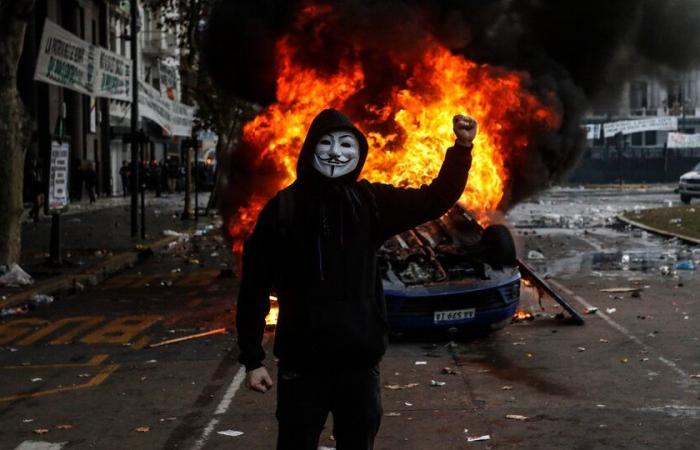
Smiling bosses. On Friday, the 149th anniversary of the Superintendency of Communication Technologies was celebrated at the Central Department of the Federal Police. They were all satisfied with the operation, which had one primary objective: break up Wednesday’s rally against the Bases Law before the bulk of the people arrived. That is, before the guilds arrived and, above all, to prevent the square from being filled with ordinary citizens who would come around at dusk, after leaving work.
None of the federal bosses could answer, for example, the question of why there were dozens of motorcycles, None of them immediately arrived at the place where they set fire to Cadena 3’s cell phone.. They also did not arrive when, minutes later, two men finished vandalizing the cell phone and calmly left in an old vehicle with the NBO 056 license plate turned upside down. The patent is trout, it does not exist. All the heads of the Federal are distracted by the information that troops fired gas from the seventh floor of the former Savings Bank, now annexed to Congress, on Hipólito Yrigoyen. No one would have accepted the image of the man who participated in riots and then was very well received behind the fences by the police. And no one can explain that among those detained are not those who burned the car, but protesters arrested 5 or 6 blocks from the square, mainly on 9 de Julio Avenue.
An old sleuth from the intelligence services reasoned: “we did this, but to disperse, so that there were no people, not to put protesters in prison. When we burned Modart, in 1988, on De Mayo and Perú Avenue, the objective was to end the act led by (Saúl) Ubaldini. There was no one arrested. Of course, in the following week a few from the SIDE were seen very well dressed.”
The central objective: dissolve the march
When the deputies came out at 1:30 p.m. to see what was happening, they approached the police formation very calmly. There was no element of aggression. From behind the police formation, an officer appeared and brutally threw gas in the faces, mainly at Carlos Castagneto and Eduardo Valdés. The message was “do not go near the square, because if we do this to the deputies, you can imagine what we will do to the others.”
As happened before and after that moment, the security forces harassed those who were in the square and even those who were arriving calmly. The uniformed men advanced in formation and, after attacking the deputies, they started the two fire hydrant trucks that were in front of Congress. The objective was always the same: to prevent the concentration from lasting until sunset.
The provocation is demonstrated by the fact that there were recently even larger mobilizations than those on Wednesday, which blocked streets due to their massiveness – for example, the university march or the CGT march on May 1 – and there was no problem. Everything passed in peace. Here Bullrich and his gang broke in.
With fewer people, it’s easier
At the time of the attack on the deputies, the security forces had already blocked the passage of the most powerful union columns, Camioneros, Smata and CTA. The police know that these unions have their own security and anything that the uniformed men do has an unforeseeable end: the police can hit and receive. And, furthermore, the security of the guilds does not allow any strange do anything. It is said that, given the climate of gossip, the unions decided not to travel the two remaining blocks to the square. The unions claim that this was not the case: that the troops prevented their passage with provocation after provocation.
The next episode was the launching of gases from the building of the former Savings Bank, on Hipólito Yrigoyen. The version is that they allowed troops to go up to the seventh floor and from there they fired the gases. Of course, it had the desired effect: dispersing the already diminished crowd.
Questions without answers
No one in the Federal Central Department could answer the question of why the motorcycles did not immediately arrive at the place where they turned around and burned the cell phone. Chain 3. Orlando Morales is an old acquaintance of everyone: of social movements and protesters. They always make it easier for you to pass in any gear. The police chiefs also know that he is always there, so he was a target of the same strategy: breaking up the march with the spectacular maneuver that means burning the cell phone of a media outlet. “This was armed,” said Morales. He was on top of the cell phone. I said I wanted to get it out. They took me by one arm, threw me to the ground, turned it over and burned it.” The security forces were 50 meters away, but no motorcycle approached.
The unusual thing is that minutes later, when the fire was already out, two individuals approached the cell phone and took things from it. It seemed like vandalization. But whatever the case, no one stopped them, no one asked them anything. Then they got into a car, with the rear license plate turned over, and left without problems. According to what was later revealed, that patent is non-existent, that is, false. In the video you hear some police say “we have to stop them”, but nothing happened.
On the same Wednesday, the image of an alleged hooded protester went viral, who went from being a “terrorist”, as the government defined him in the official statement, to crossing the fences and being received with open arms by the uniformed men. There are more images of this nature, but they require a more precise check.
familiar faces
Of course, no force or organization recognizes the hooded men. Those from the Federal Intelligence Agency (AFI) assure that they are without people and that the new head, Sergio Neiffert, is not in a position to sign any orders yet. He is a total novice, to the point that the day he took office they had to explain basic operating issues and confidentiality measures to him.
The focus is more on what is known as the feathers, Federal Police intelligence. They are very organic agents dedicated to gathering information, but from time to time they go out to the streets to carry out operations. The government affirms that there were three security forces in the square – the Gendarmerie, the Prefecture and the Federal Police – and that none of them would risk having their people arrested by another force. The argument is very weak: the Federal Government had total control of the operation, with Patricia Bullrich monitoring from the Central Department. The brutal attack on the deputies, when there was no conflict and without any justification, was defended by the minister. It seems obvious where the order came from.
The unprecedented hunt
The feathers of the Federal Police raise even more suspicions when it is verified that among the detainees there is not a single one associated, for example, with the burning of Cadena 3’s cell phone. And the vast majority were arrested far from Congress Square, mainly on 9 de Julio Avenue.
In the list of 16 detainees provided by Judge María Servini, six are accused of throwing stones, two of kicking police officers and the rest of astonishing charges: jumping the fence, being belligerent (?), photographing, helping the photographer , a university professor for kicking a police officer (you can see in the image that it is a false accusation), and the most seriously accused are two accused, one for having a grenade (it seems like a trout) and the other, apparently, for having set fire to the bicycles. Despite this description by the magistrate, these are facts of little relevance, the government talks about terrorism and preventing the functioning of institutions.
Modart is in fashion
Wednesday’s operation was not only intended to break the mobilization against the Bases Law, but also to imprison protesters and instill fear of protesting from now on. The whole climate was repressive. The detainees were mistreated in a way that has little precedent in recent years: the women were kept for hours and hours on a police cell phone, handcuffed, without being allowed to go to the bathroom. When the lawyers left Comodoro Py to get some air and talk to the media, they were not allowed back in. Contact of detainees with their families was not allowed and some were transferred to prison units – now managed by Bullrich – without their situation having been resolved. On Saturday, the relatives were not allowed to enter the Ezeiza prison, where the women are housed.
The old SIDE man remembered and confessed the adventures of the intelligence agents. “Yes, we did things like this on Wednesday. But we did them with a small group of infiltrators to disperse the people, not to imprison them. In that act by Saúl Ubaldini, when he was speaking in Plaza de Mayo, Modart was vandalized. The goal was for people to leave the event. No more than that. Wednesday was different: they imprisoned people and left them inside for a few days. The objective is to scare. Ours was lighter. Of course, the following week (February 1988) you saw the agents all dressed up in the clothes they took from Modart.”





